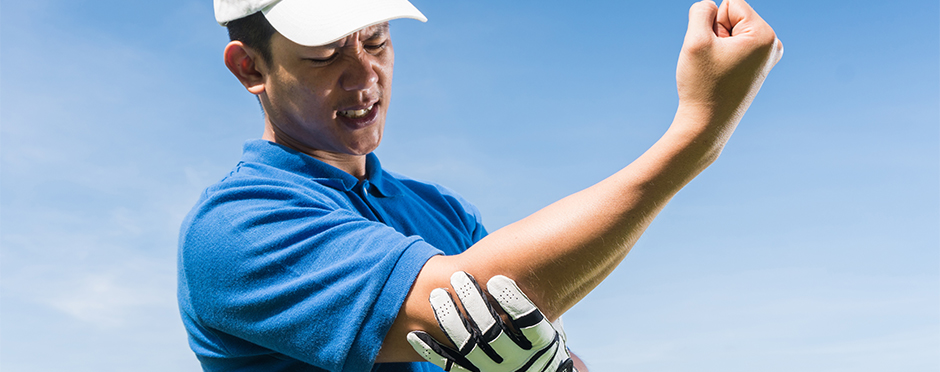
Tips for Tackling Golfer’s Elbow
1 CommentAs a physical therapist, I see many athletes who experience a golfer’s elbow, medically referred to as medial epicondylitis. This condition is characterized by a burning ache along the inside edge of the elbow, which worsens with gripping or during certain wrist motions. While it is a fairly common issue among athletes and recreational sports enthusiasts, it’s most commonly experienced by golfers.
Background
What is Golfer’s Elbow?
Golfer’s elbow is a form of tendinopathy that affects the muscles located on the inside of the forearm. Collectively and with overlapping roles, these muscles flex (bring the palm towards the inner forearm) and pronate (turn towards a thumb-down position) the forearm, hence being termed the “flexor-pronator muscle group.” It often results from repetitive use of these muscles, leading to micro-tears and inflammation. Commonly, I see patients who are most affected during the ball contact and follow-through phases of their swing. However, patients can also experience pain with daily tasks such as cooking, cleaning, or grooming.
Who is Most Affected?
The age group most commonly affected by golfer’s elbow is between 35 and 54 (coincidentally, the average age of a golfer in the USA is 54). The cumulative effects of repetitive stress over time are typically why the condition is usually seen in middle-aged individuals. However, anyone who engages in activities that strain the flexor-pronator muscle group can develop this condition.
Treatment
Manual Therapy
Manual therapy is an effective way to manage a golfer’s elbow. Soft tissue mobilization, stretching, and massage can help improve circulation, reduce inflammation, and promote healing. To reduce pain in these areas, a skilled therapist may target their treatment around the inside of your elbow and the front side of your forearm.
Eccentric Exercises
Eccentric exercises, which involve lengthening the muscle under tension, are particularly beneficial. These exercises can help strengthen the affected muscles and tendons, ultimately reducing pain and improving function. For example, dangle your hand off the edge of a table while holding a dumbbell. Start with your wrist curled, and slowly uncurl without dropping the weight. Repeat 6-10 reps on your affected side.
Kinesiotaping
Kinesiotaping can be another helpful treatment for a golfer’s elbow. You can support and reduce muscle and tendon swelling by applying tape to the elbow and forearm. This can help alleviate pain and improve range of motion. However, it’s important to strengthen the underlying muscles rather than relying on tape for long-term management.
Golf Swing Assessment
In the same way that a marathoner can analyze their running gait under a slow-motion camera, a golfer can assess their swing. Excessive wrist flexion, lack of follow-through on swing, or poor grip can contribute to elbow pain in golfers. Check out Athletico.com to find a physical or occupational therapist closest to you specializing in golf assessment!
Prevention and Self-Care
Preventing golfer’s elbow is crucial, and self-care plays a significant role in managing the condition. Here are a few tips to keep in mind:
- Warm up and stretch: Always warm up before engaging in any physical activity and incorporate stretching exercises to prepare your muscles and tendons.
- Strengthen muscles: Work on strengthening the forearm, wrist, and grip muscles through targeted exercises. Your physical or occupational therapist can guide you to which exercises are best for you.
- Start the season slow: If you haven’t golfed the entire winter, starting with a full weekend tournament can easily lead to overuse. Start the season slow to build up tolerance.
Our Team is Here to Help!
Golfer’s elbow can be challenging to manage, but with the right treatment approach and preventive measures, you can find relief and improve your performance. If you suspect you have a golfer’s elbow, seek the guidance of a physical or occupational therapist to create a personalized treatment plan tailored to your specific needs. Start by contacting a clinic near you to schedule a free assessment in person or virtually through our telehealth platform.
*Per federal guidelines, beneficiaries of plans such as Medicare, Medicaid, Tricare, VHA and other federally funded plans are not eligible for free assessments.
The Athletico blog is an educational resource written by Athletico employees. Athletico bloggers are licensed professionals who abide by the code of ethics outlined by their respective professional associations. The content published in blog posts represents the opinion of the individual author based on their expertise and experience. The content provided in this blog is for informational purposes only, does not constitute medical advice and should not be relied on for making personal health decisions.
Reference:
1. Landesa-Piñeiro, Laura and Leirós-Rodríguez, Raquel. ‘Physiotherapy Treatment of Lateral Epicondylitis: A Systematic Review’. 1 Jan. 2022 : 463 – 477.

1 Comment
Philip
Your expert advice has made a tangible difference in my game. I’m so grateful for your blog!